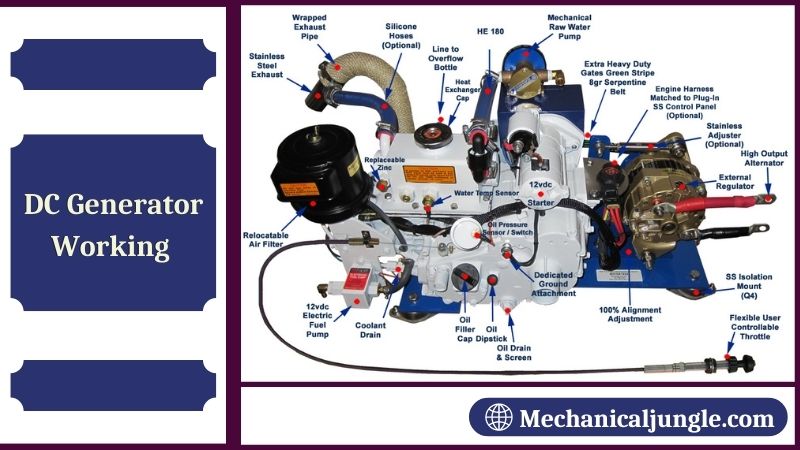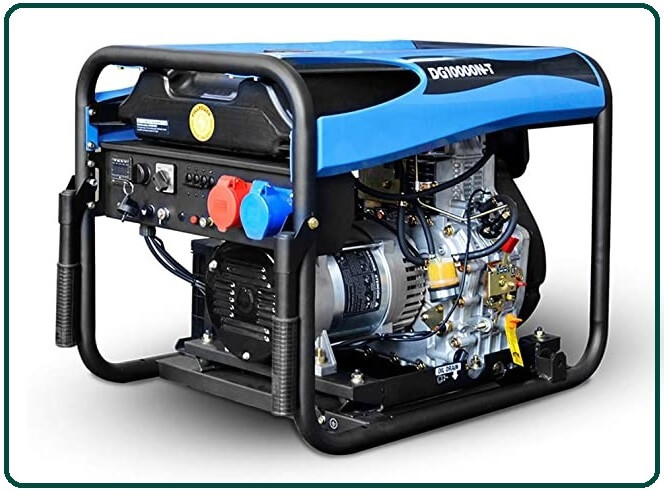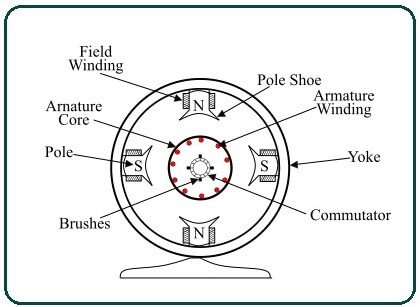
What Is a DC Generator?

A direct-current (DC) generator is a rotating machine that supplies an electrical output with unidirectional voltage and current.
As mentioned earlier, they are two types of generators based on the output: AC and DC generators. The main function of a direct current generator is to convert mechanical energy into electricity.
A DC generator is an electrical machine whose main function is to convert mechanical energy into electricity. When the conductor slashes magnetic flux, an emf will be generated based on the electromagnetic induction principle of Faraday’s Laws.
This electromotive force can cause a flow of current when the conductor circuit is closed. There are many sources that provide mechanical energy for DC generators, such as internal combustion engines, water, gas and steam turbines, & even hand cranks.
There is a reverse function defined for a DC generator: this reverse job can be accomplished using an electric motor. DC motor converts electricals powers into mechanical energy. DC generators produce electrical powers base on the principle of Faraday’s law of electromagnetic induction.
Based on this law, when a conductor moves in a magnetic field, the magnetic lines of forces are cut. This leads to electromagnetics forces induction in the conductor.
“What is the working principle of DC generators?” To get a clear answer to the questions, let us also give a brief overview of its parts and components. In the following section, we will briefly walk you through the main parts of a DC generator and how they work.
Construction of a DC Generator:
In the previous section, we explain what a DC generator is in a nutshell. Now we want you to get more acquainted with its construction.
A DC generator consists of several components that help the whole machine to function as it should. More than ten parts for DC generators are mentioned in various articles.
Here are the schematics diagrams of DC generators.

DC generators consist of six main parts, which are as follows:
#1. Yoke
The outer frames of DC generators are hollow cylinders made of cast steel or rolled steel, known as a yoke. The yoke serves the following two purposes.
- This field pole supports the core and acts as a protective shield to the machine.
- This field provides a path for the magnetic flux generated by the winding.
#2. Magnetic Field System
The magnetic field system of the DC generator is the stationary part of the machine. This produces the main magnetic flux in the generator. It consists of an equal number of pole cores bolted to the yoke and field winding wound around the pole core.
The field system of the DC generator consists of main poles, i.e., the poles project inward, and each pole core has a curved surface pole shoe. The pole shoe serves two purposes.
- This field provides support to the coil.
- It reduces the reluctance of a magnetic circuit by increasing its cross-sectional area.
Poles cores are made of thin laminations of sheets of steel that are insulated from each other to reduce eddy current losses. Fields coils are connected in series with each other such that when current flows through the coil, alternating north and south poles are produced in the direction of rotation.
#3. Armature Core
The armature core of the DC generator is mounted on the shaft and rotates between the field poles. It has slots on its outers surface, & armatures conductors are placed in these slots. The armature core is made of softs iron laminations that are insulated from each other and are tightly joined together.
In smaller machines, the laminations are attached directly to the shaft, while in larger machines, they are mounted on a spider. Laminated armature cores are used to reduce eddy current loss.
#4. Armature Winding
Insulated conductors are inserted into the slots of the armature core. The conductor is suitably connected. These connected arrangements of conductors are known as armature winding. Two types of armature winding are used – wave winding and lap winding.
#5. Commutator
A commutator is a mechanical rectifier that converts the alternating emf generated in the armature winding into a direct voltage across the load terminals.
The commutator is made up of wedge-shaped copper sections that are insulated from each other and from the shaft by sheets of mica. Each section of the commutator is connected to the ends of the armature coil.
#6. Brushes
The brushes are mounted on the commutator & are used to collect current from the armature winding. The brushes are made of carbon and are supported by a metal box called brush holders.
The pressures exerted by the brushes on the commutators are adjusted and maintained at a constant value by means of springs. Current flows from the armature winding through the commutator and carbon brush to the external circuit.
Working Principle of DC Generator:

In the previous sections, we discussed what defines a DC generator and how it works. In this section, we are going to talk about the working principles of DC generators. As mentioned earlier, a DC generator is an energy converter that converts mechanical energy into electricity.
This change in energy form is based on the principle of electromagnetic induction, which means that wherever there are changes in magnetics fluxes associated with the conductor, an emf or an electromagnetic force is induced in it.
This inductance causes the flow of current in case the conductor circuits are closed. So, based on what we have said so far, the main requirements of DC generators are the magnetics field and the conductor. The conductor proceeds to cut off the magnetic fluxes.
Therefore, we can say that DC generators work on the principle of dynamically induced electromagnetic force. This is what Faraday’s law of electromagnetic induction states: When a current-carrying conductor is placed inside a varying magnetic field, an emf is induced in the conductor.
On the other hand, & based on Fleming’s right-hand rule, wherever the direction of motion of the conductor changes, the direction of the induced current also changes; imagine that the armature rotates clockwise, and a conductor moves upwards to the left.
Now when the armature has completed half a revolution, the direction of motion of the conductor will reverse downwards. Hence the direction of current in each armature will keep changing.
But with a split ring commutator, the connections to the armature conductors are reversed when the current is reversed. Hence, we get unidirectional current at the terminals.
Working of DC Generator:
DC generator is an energy converter that converts mechanical energy into electricity. This change in energy form is based on the principle of electromagnetic induction, which means that wherever there are changes in the magnetic flux associated with the conductor, an emf or an electromagnetic force is induced in it.
DC generators work on the principle of dynamically’s induced electromagnetic forces. When a conductor is placed in a varying magnetic field, electromotive forces are induced within the conductor. This induced emf magnitude is measured using the equation for the electromotive force of a generator.
If closed paths are provided to the conductor, the induced current will circulate within the closed path. In this generator, the field coil will generate an electromagnetic field as well as the armature conductor will be turned into the field.
Therefore, an electromagnetically induced electromotive force (EMF) will be generated within the armature conductors. The path of the induced currents is provided by Fleming’s right-hand rule.
Parts of DC Generator:
The DC generators consist of the following parts –
#1. Stators
Stators are sets of two magnets placed in such a way that opposite polarity faces each other. The purpose of the stators is to provide a magnetic field in the region where the coil rotates.
#2. Rotor
The rotor is a cylindrical laminated armature core with slots.
#3. Field Coils
To produce a magnetic field, field coils are placed over the pole core. The field coils of all the poles are connected in series. When currents flow through them, the adjacents poles acquire opposite polarity.
#4. Poles
The main function of poles is to support the field coil. This increases the cross-sectional area of the magnetic circuit, resulting in a more uniform propagation of the magnetic flux.
#5. Pole Shoe
Pole shoe is used to protect the field coil from falling & to increase the uniform dispersion of magnetic flux. The pole shoes are attached to the yoke.
#6. Commutator
A commutator is cylindrical in shape. Several wedge-shaped, rigidly drawn copper sections form a commutator. Functions of a Commutator:
For connecting fixed external circuits to rotating armature conductors by means of brushes and Conversion of alternating induced current into direct current.
An Easy-To-Understand Example of DC Generator Working Principle:
Let us simplify the working and working principles of the DC generator for you. You have to note that if the generator is very small, for example, it is used for a shop, small workshop, cinema, or home, then the prime mover or mechanical energy supplier is a diesel engine.
If the generator is very large, like in power plants, the prime mover will be a water, steam, or gas turbine. As the mechanical energy supplied by the prime mover is given to the generator, the generator armature starts rotating.
Usually, the poles on the yoke are made of permanent magnets. This means that according to Faraday’s laws of electromagnetic induction, the armature conductors cut off the weak magnetic field established by the permanent magnet, and a small amount of emf is induced in the armature winding.
This induced electromagnetic force transmits a small amount of current through the field winding and strengthens the supplied magnetic flux and hence the induced EMF. Thus, due to the reinforcement of flux and emf, the generator provides the rated voltage.
EMF Equation of DC Generator:
The EMF equation for DC generators are expressed as,
Where,
- Eg- Generated EMF across any parallels path
- P- Total number of poles in the fields
- N- Rotational speed of armatures(rpm)
- Z- Total number of armatures conductors in the field.
- Ø- Magnetics flux produced per pole.
- A- number of parallel paths in the armature.
- Eg- (PØNZ)/60A
Frequently asked questions (FAQs) that could be included in your article about DC generators:
What Is a Dc Generator and How Does It Work?
A DC generator is a machine that converts mechanical energy into electrical energy using the principles of electromagnetic induction. It produces a direct current (DC) output.
What Are the Main Components of a Dc Generator?
The main components include the yoke, magnetic field system (field poles and field winding), armature core, armature winding (wave or lap winding), commutator, and brushes.
How Does the Commutator Function in a Dc Generator?
The commutator is a crucial part that converts the alternating EMF induced in the armature winding into direct current across the load terminals. It ensures the current flows in one direction.
What Are the Types of Armature Winding Used in Dc Generators?
DC generators commonly use two types of armature windings: wave winding and lap winding. These configurations determine how the conductors are connected to generate the desired output.
What Is the Role of Brushes in a Dc Generator?
Brushes are used to collect current from the commutator and transfer it to the external circuit. They are typically made of carbon and are mounted on brush holders to maintain contact with the commutator.
How Is the Emf Equation of a Dc Generator Defined?
The EMF (electromotive force) equation of a DC generator relates the generated voltage to the number of poles, rotational speed of the armature, magnetic flux per pole, and number of armature conductors.
What Are the Applications of Dc Generators?
DC generators find applications in various fields including portable power supplies, small-scale electrical systems, battery charging, and in industries requiring stable DC power.
How Does a Dc Generator Differ from an Ac Generator?
Unlike AC generators that produce alternating current, DC generators provide a unidirectional flow of current. This difference impacts their construction, operation, and applications.
What Are the Maintenance Requirements for Dc Generators?
Maintenance involves periodic checks of brushes, commutator condition, insulation, and lubrication of moving parts. Regular inspections ensure efficiency and longevity of the generator.
What Are the Advantages of Using Dc Generators?
DC generators offer advantages such as simplicity in design, suitability for low power applications, precise control over output voltage, and compatibility with DC-based equipment.

